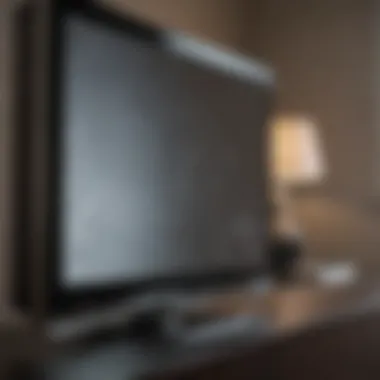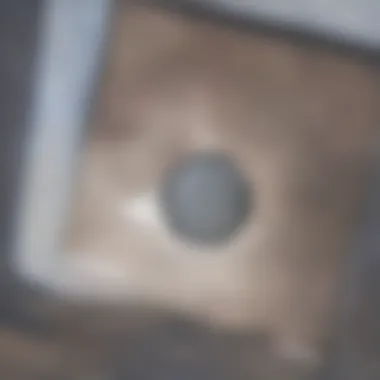Expert Tips for Safely Cleaning Your LCD TV Screen


Intro
Cleaning an LCD TV screen requires specific methods and tools to ensure clarity without causing damage. LCD screens are delicate, and improper cleaning can lead to streaks, scratches, or even permanent damage to the screen's surface. Therefore, understanding effective approaches to maintain the pristine condition of an LCD display is crucial. This guide outlines effective cleaning techniques, suitable materials, and advice for routine maintenance, aiming to help you prolong the life of your television while providing an optimal viewing experience.
The Importance of Proper Cleaning Techniques
Maintaining the cleanliness of your LCD TV offers multiple benefits beyond aesthetics. Regular cleaning removes dust, fingerprints, and residue, significantly improving picture quality. Grime on the screen can distort visuals and affect your overall enjoyment while watching movies or shows. Thus, adopting proper cleaning methods is an investment in your viewing pleasure.
"A clean screen is key to a good viewing experience. Dust and smudges hinder your enjoyment of content."
Ideal Tools for Screen Cleaning
When selecting tools for cleaning, it is important to choose those that will not scratch or harm the screen. The following items are recommended:
- Microfiber Cloths: These cloths are non-abrasive and effective at picking up dust and smudges. Always ensure they are clean to avoid scratching.
- Distilled Water: This is preferable over tap water, which may contain minerals that can leave deposits.
- Screen Cleaning Solutions: Always verify that the products are safe for LCD screens, such as those from brands like Jeff's and Screen Mom.
- Spray Bottle: For easy application of cleaning solutions or distilled water.
Step-by-Step Cleaning Procedure
- Power Down the TV: Always turn off your LCD TV and unplug it before cleaning to prevent any electrical issues.
- Dust Off the Screen: Gently wipe the screen using a dry microfiber cloth to remove loose dust and debris. Use a circular motion to ensure thorough cleaning.
- Apply Cleaning Solution: If necessary, lightly mist the cloth with distilled water or a screen-safe cleaner. Never spray directly onto the screen.
- Wipe the Screen: Using the damp cloth, wipe the screen in a gentle, circular motion. Avoid applying too much pressure, as this can damage the screen.
- Dry the Screen: Use a dry section of the microfiber cloth to remove any moisture, ensuring that no streaks remain.
What to Avoid
To maintain your LCD screen's integrity, refrain from using the following:
- Paper Towels or Rough Fabrics: These can scratch the delicate surface.
- Window Cleaners or Alcohol: These substances can break down the screen’s protective coating.
- Excessive Force: Always clean gently to avoid risking damage.
Routine Maintenance Tips
Establishing a routine maintenance schedule can drastically enhance your LCD screen's longevity. Here are some tips:
- Regularly dust the screen once a week.
- Clean with solutions as needed, ideally once a month.
- Keep the TV remote control clean too, as it can transfer oils onto the screen surface.
Closure
Employing the right methods when cleaning your LCD TV screen is imperative to ensure its durability and functionality. By using suitable tools and adhering to recommended procedures, you can keep the screen in optimal condition, thus improving your viewing experiences. Consistent care will not only enhance picture clarity but also contribute to the overall enjoyment of your entertainment system.
Understanding Screens
Understanding LCD screens is crucial when discussing effective cleaning methods. Proper knowledge of these screens can help to prevent damage during cleaning and maintain optimal clarity. LCD, or Liquid Crystal Display, screens are popular for their vibrant colors and sharp images. They are used in televisions, monitors, and various other devices. This awareness allows users to choose suitable cleaning techniques and materials to avoid any potential harm.
What is an Screen?
An LCD screen utilizes liquid crystals sandwiched between layers of glass or plastic. These crystals interact with light to create images. The structure enables the screen to be lightweight and slim, making it ideal for modern electronic devices. As a result, LCD screens offer excellent picture quality and energy efficiency. It is important to understand this technology, as it influences how one should approach cleaning. Knowing the screen's delicate nature helps you to take the necessary precautions while performing maintenance.
How Screens Work
LCD screens operate by manipulating light. They contain an array of pixels that change color and intensity in response to electrical signals. Each pixel consists of sub-pixels that combine red, green, and blue to create a full spectrum of colors. Behind the LCD panel, a backlight provides the necessary illumination. This method allows for thin and lightweight displays. The way these screens function is significant when cleaning. Using improper techniques or materials can lead to permanent damage to the panel or diminish image quality. Therefore, a clear grasp of how LCD technology works is essential to preserve the integrity and lifespan of the display.


Importance of Proper Cleaning
Cleaning an LCD TV screen is more than a simple chore; it is a crucial part of maintaining the display’s performance and longevity. Proper cleaning ensures that users enjoy a clear picture and vibrant colors. When dust and smudges accumulate, they can obstruct the view and diminish the overall viewing experience. Therefore, understanding the importance of this process is key to keeping the television in optimal condition.
Impact of Dust and Smudges
Dust and smudges can significantly affect an LCD screen’s visual output. A layer of dust can scatter light, leading to a washed-out image. Smudges from fingerprints and other contaminants can create distracting marks, diverting attention from content. Moreover, if left unaddressed, these contaminants may cause permanent damage over time.
When the screen is not clean, the colors may not appear as intended, and contrast can suffer. This can detract from the enjoyment of movies, shows, and games. A clear screen contributes not only to visual satisfaction but also to maintaining the integrity of the screen’s surface. Cleaning is essential not only for aesthetics but for functionality as well.
Long-Term Maintenance Benefits
Regularly cleaning the LCD screen can yield long-term benefits. First, it can prolong the life of the display. Dust and grime can lead to malfunctions or issues like screen burn, which is often irreversible. By taking the time to clean the screen carefully, users can avoid costly repairs or even the need to replace the television altogether.
Furthermore, a clean screen enhances the viewing experience. Colors will be truer, and connections will be clearer. In an environment where aesthetics matter—like in well-designed interiors—it is vital for the television to complement the room's overall look. Maintaining a clean screen supports this aspect by ensuring it contributes positively to the space.
In summary, proper cleaning is an essential practice. From improving image quality to extending the life of the device, the act of cleaning the LCD screen should not be underestimated.
What to Use for Cleaning
When it comes to cleaning an LCD TV screen, the choice of tools and cleaning solutions is critical. Using appropriate materials reduces the risk of damaging the screen while optimizing clarity. The right combination can remove dust, fingerprints, and other smudges without leaving streaks or scratches.
Microfiber Cloths
Microfiber cloths are essential tools for cleaning LCD screens. They are designed to lift and trap dust and dirt effectively without scratching delicate surfaces. The fibers can get into the tiny grooves and cracks of the screen, ensuring a more thorough cleaning.
One of the key benefits of microfiber is that they do not leave lint behind, which is often a concern with traditional cloths. To maintain their effectiveness, it is best to wash them without fabric softeners, as softeners can create residues that harm performance. Additionally, microfiber cloths are reusable and environmentally friendly, making them a popular choice for sustainable cleaning practices.
Cleaning Solutions
Choosing the right cleaning solution is equally important as selecting the correct cloth. Several options are available, each with its benefits and limitations.
Distilled Water
Distilled water is a preferred cleaning solution for many individuals dealing with LCD screens. The primary characteristic of distilled water is its purity; it lacks the minerals found in tap water that could leave residue on the screen. This makes it a safe choice for regular cleaning without the risk of streaking.
One unique feature of distilled water is its non-reactive nature. It does not contain harmful chemicals that can damage the display. However, it may not be effective against some stubborn stains or grime, necessitating the use of additional substances in more challenging situations.
Vinegar Mixtures
Vinegar mixtures are another common choice among LCD screen owners. The acetic acid in vinegar makes it an effective cleaner for cutting through grease and smudges. Many users prefer a solution that combines equal parts distilled water and vinegar, as it creates a gentle yet effective cleaner.
The key benefit of vinegar is its natural origin. It avoids harsh chemicals and is relatively safe for household use. However, due to its strong odor, it may not be suitable for everyone. Additionally, vinegar can potentially strip coatings from some screens, so caution should be exercised.
Commercial Screen Cleaners
Commercial screen cleaners are formulated specifically for electronic displays. They often contain a blend of cleaning agents that cut through grime while being safe for LCD screens. The convenience of these products is a notable advantage; they are easy to use and provide results quickly.
A key characteristic of commercial cleaners is the presence of anti-static properties, helping to repel dust post-cleaning. On the downside, some commercial cleaners may contain alcohol or other chemicals that could harm the screen over time. It is essential to choose reputable brands and verify their compatibility with LCD displays.


In summary, when cleaning an LCD TV screen, the tools and solutions you choose play a vital role in maintaining the screen's clarity and longevity. Microfiber cloths are widely recommended for their gentle cleaning properties. Distilled water, vinegar mixtures, and commercial screen cleaners offer various solutions, each with its strengths and weaknesses. Understanding these elements can greatly aid in effective cleaning.
Cleaning Techniques
Cleaning techniques for an LCD TV screen are critical for maintaining its clarity and functionality. When executed correctly, these methods can protect the display from scratches and damage. The right cleaning approach can also prolong the lifespan of the screen, ensuring that it continues to deliver high-quality viewing experiences. Not all techniques are suitable, and understanding the nuances between them is essential.
Off Power Cleaning
Performing cleaning on an LCD screen while it is powered off is vital. This approach not only reduces the chances of electrical mishaps but also enhances the visibility of dust and smudges. When the screen is off, the surface appears darker, highlighting areas that need attention. Additionally, cleaning an off screen minimizes the risks of static charge causing dust to cling back onto the glass, thereby ensuring a thorough clean.
- Turn off the TV and unplug it from the wall socket to eliminate any risk of electric shock.
- Use a soft microfiber cloth to gently wipe the screen without applying excessive pressure.
- This method allows for a careful inspection of the screen. Moving across the surface can help identify stubborn spots that might have gone unnoticed.
"Regularly cleaning an off screen ensures it remains in optimal condition."
Circular Motion Method
The circular motion method is often recommended for cleaning due to its effectiveness. Applying this technique involves using soft motions while cleaning to dislodge dirt without causing streaks.
- Start at a corner of the screen.
- Gradually move in small circles, either clockwise or counterclockwise.
- Pay extra attention to areas where smudges often accumulate, such as the edges.
This method helps disperse the cleaning solution uniformly across the surface. It prevents any hard-to-remove streaks that can arise from cleaning in a linear fashion. The circular approach ensures that all sections of the display receive equal attention.
Pressure Application Tips
Applying the right amount of pressure is crucial in cleaning an LCD screen. Too much pressure can result in damage, while too little may not clean effectively.
- Use fingers or lightweight cloth: When cleaning, allow the weight of the cloth or your fingers to do the work. Avoid pressing down forcefully.
- Focus on tough spots: Gently apply slight pressure on areas with stubborn grime, but limit to a few seconds before moving to a different area.
Be mindful that consistent, light pressure is often more effective than applying heavy force. This technique enables you to clean the screen safely while maximizing efficiency.
Materials to Avoid
When it comes to cleaning an LCD TV screen, choosing the right materials is vital. Using unsuitable cleaning items can lead to screen damage, reduced clarity, and a shorter lifespan for the device. It is important to approach this task with caution. In this section, we will delve into specific materials that should be avoided, focusing on their negative impact on the screen's integrity and functionality.
Paper Towels
Using paper towels to clean an LCD screen is not advisable. These towels may seem harmless, but they carry the potential to scratch the delicate surface of the screen. The texture of most paper towels is coarse, which can lead to micro-abrasions over time. This diminishes the screen clarity and can even induce permanent damage. Instead of paper towels, opt for microfiber cloths as they are gentle and effective.
Harmful Chemicals
Certain chemicals can significantly damage LCD screens. It's crucial to steer clear of these cleaners as their harsh properties can erode the screen’s protective layers. Common substances that fit this category are alcohol-based cleaners and ammonia. Each has distinct characteristics, so let's break these down further.
Alcohol-Based Cleaners
Alcohol-based cleaners are prevalent choices for many cleaning tasks. However, they pose a serious risk to LCD screens. Alcohol's main characteristic is its potent solvent properties, which can remove dirt and grime efficiently. Yet, this same feature makes it detrimental to screen coatings. Regular use can strip away the anti-reflective coatings of the screen, leading to a dull appearance over time. Therefore, one must refrain from using alcohol-based cleaners to avoid long-term visual issues.
Ammonia
Ammonia, a common cleaning agent, is another substance to avoid. It is effective at cutting through grease and grime but has severe implications for LCD screens. Its key characteristic is its high alkalinity, which can lead to damage to the sensitive electronic components within the screen. The unique feature of ammonia is its ability to produce fumes that may contribute to clouding the screen over time. Thus, while it might seem like an effective choice, using ammonia on your LCD screen is highly inadvisable.


Avoiding Abrasive Cloths
Beyond liquid cleaners, the cloth used for cleaning plays an important role. Abrasive cloths can ruin the smooth surface of an LCD screen. These materials may create scratches that are not easily seen but can worsen visibility over time. It is best to use soft, lint-free microfiber cloths designed specifically for electronic devices. This precaution not only preserves the screen’s condition but also ensures optimal viewing quality.
Routine Maintenance Tips
Maintaining the clarity and functionality of an LCD TV screen involves more than just cleaning it. Regular maintenance is crucial to prolonging the life of the screen and enhancing its performance over time. By adopting routine maintenance tips, users can ensure their television remains in optimal condition.
The practice of regular maintenance creates a barrier against dust accumulation, fingerprints, and smudges. This not only keeps the viewing experience pristine but also reduces the likelihood of permanent marks on the screen surface. Furthermore, it minimizes the need for deep cleaning, which can be more invasive and carries a risk of damage.
Frequency of Cleaning
The frequency of cleaning your LCD TV screen depends on various factors, including the environment where the television is situated. A high-traffic area with pets or children may require more frequent cleaning compared to a room with less activity. As a general guideline, it is advisable to clean the screen once every two weeks.
However, users should observe the screen and clean it when significant dust or fingerprints accumulate. If you notice a decrease in picture clarity or see reflections that interfere with viewing, it is time to clean the screen. Regular cleaning prevents larger amounts of grime buildup, making each cleaning session easier and more effective.
Dust Prevention Strategies
Preventing dust from accumulating on your LCD TV screen can greatly reduce the need for cleaning. Here are some strategies to consider:
- Placement: Position the television away from open windows or direct airflow from fans or heating vents.
- Use Covers: Consider using a soft cover that can be placed over the TV when it is not in use.
- Regular Dusting: Dust surrounding furniture and accessories regularly to minimize the overall dust in the room.
- Air Purifiers: Installing air purifiers can greatly reduce dust particles in the air, providing a cleaner environment for your television.
Implementing these strategies can lead to a more enjoyable viewing experience with less maintenance effort.
By adhering to these maintenance tips, you will ensure that your LCD TV screen remains clear. This will not only enhance your viewing enjoyment but may also extend the life of your device. Regular care leads to optimal display performance and user satisfaction.
Advanced Care Techniques
In the realm of LCD screen maintenance, advanced care techniques are essential to ensure longevity and optimal performance. Many users neglect the necessity of such practices, thinking that basic cleaning is sufficient. However, understanding advanced care can help prevent permanent damage to the screen as well as maintain the clarity of the display.
Regular cleaning is not enough when faced with stubborn stains or persistent dust accumulation. Advanced techniques focus on dealing with the more challenging aspects of LCD maintenance, such as removing residues from greasy fingerprints or dust buildup that can diminish picture quality over time.
Using the right approach and materials not only enhances the overall viewing experience but also reflects mindfulness about the condition of one’s investment. Additionally, these techniques can extend the lifespan of an LCD TV screen, ultimately saving users from costly repairs or replacements.
Dealing with Stubborn Stains
Stubborn stains on an LCD screen can be a frustration. They might come from various sources including food spills, greasy fingerprints, or even dust that has settled for too long. The challenge lies in removing these stains without damaging the screen itself.
- Identify the Stain: Different stains require different treatment methods. Knowing what type of stain you are dealing with is crucial. For example, a grease stain may need a different solution than a dusty one.
- Use Appropriate Solutions: If a solution of distilled water and white vinegar did not work, consider purchasing a cleaner specifically made for LCD screens, such as the Screen Cleaner from Whoosh!. Always check if it's safe by reading labels.
- Soft Cloth Application: Utilize a microfiber cloth to gently buff the stained area. Apply minimal pressure to not risk further damage.
- Patience is Key: For very stubborn stains, it may take several treatments. Always allow the screen to dry completely before checking if it requires additional cleaning.
It is important to avoid harsh chemicals which can strip the protective coating of the screen.
"The right cleaning methods are crucial for prolonging the life and maintaining the quality of an LCD TV screen."
Closure
The conclusion serves as a crucial element of our guide to cleaning LCD TV screens. It synthesizes the information provided in previous sections and emphasizes the significance of regular maintenance. An LCD screen can be a significant investment, and proper care is essential to prolong its lifespan.
Proper cleaning not only improves the viewing experience but also prevents long-term damage. Dust and smudges can accumulate over time, affecting picture quality and overall performance. Thus, establishing a consistent cleaning routine can help avoid these issues.
Final Thoughts on Maintenance
- Regular Cleaning: This helps in maintaining clarity and enhancing the viewing experience.
- Correct Tools: Use microfiber cloths and appropriate cleaning solutions. Avoid harsh chemicals that could cause irreparable damage.
- Technique Matters: Utilizing a gentle approach during cleaning is necessary to avoid unintended harm.
Adopting these practices ensures the screen remains free from dust and stains while enhancing its aesthetics. Regular maintenance can also lead to a more satisfying experience of using technology. By implementing these guidelines, users position themselves to enjoy their LCD screens for many years.















